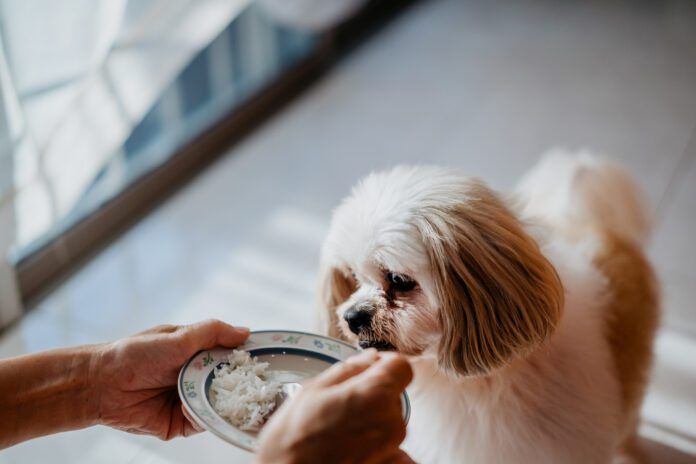A chicken and rice diet is a common home remedy for dogs experiencing digestive upset, especially diarrhea. The bland combination is typically palatable for dogs and can help provide some nourishment during recovery. But how much chicken and rice should you feed, how long should your dog be fed chicken and rice, is it safe to feed your dog chicken and rice every day, and is there a better alternative? Let’s break it down.
The combination of chicken and white rice is easy on the stomach and provides easily digestible protein and carbohydrates. When your dog has diarrhea, switching to a bland diet gives their digestive system a break from heavier, harder-to-digest ingredients, like fats. The chicken you use should be unseasoned, boneless, skinless chicken breast; the legs, thighs, and skin of chicken all have a higher fat content that can worsen diarrhea and cause further gastrointestinal (GI) upset.
How to Boil Chicken and Rice for Your Dog
When cooking the chicken, boil it until it reaches an internal temperature of at least 165°F (74°C). Do not feed raw chicken, as the bacteria present can worsen your dog’s illness, especially with an already compromised system. The rice should be plain white rice and should not include any butter, oil, or seasoning.
How Much Chicken and Rice to Feed a Dog
When determining how much chicken and rice to feed, a good starting place is about 2% to 3% of your dog’s body weight per day in total food. When feeding a temporary chicken and rice diet, aim for a 2:1 ratio of rice to chicken and split up the daily amount into multiple small meals given throughout the day. You don’t want to overload your dog’s digestive system. For example, a 22-lb. (10 kg) dog should eat around 0.55lbs (250 g) of food daily, which is roughly 165 g of rice and 85 g of chicken.
Our chart on how much chicken and rice to feed your dog breaks everything down for you:
| Dog Weight | Total Daily Food | Chicken | Rice |
| 5 kg (11 lbs) | 100 – 150 g (0.22 – 0.33lbs) | 33 – 50 g | 70 – 100 g |
| 10 kg (22 lbs) | 200 – 300 g (0.44-0.66lbs) | 65 – 100 g | 130 – 200 g |
| 15 kg (33 lbs) | 300 – 450 g (0.66 – 1lb) | 100 – 150 g | 200 – 300 g |
| 20 kg (44 lbs) | 400 – 600 g (0.88 – 1.32lbs) | 130 – 200 g | 270 – 400 g |
| 25 kg (55 lbs) | 500 – 750 g (1.1 – 1.6lbs) | 170 – 250 g | 330 – 500 g |
| 30 kg (66 lbs) | 600 – 900 g (1.3 – 2lbs) | 200 – 300 g | 400 – 600 g |
| 35 kg (77 lbs) | 700 – 1050 g (1.5 – 2.3lbs) | 230 – 350 g | 470 – 700 g |
| 40 kg (88 lbs) | 800 – 1200 g (1.7 – 2.6lbs) | 270 – 400 g | 530 – 800 g |
You should feed your dog chicken and rice for no longer than two to three days, or until their stool becomes firm and regular. Once diarrhea stops, start reintroducing your dog’s regular food slowly over the next few days by mixing it with the chicken and rice:
- Day 1: 75% chicken and rice, 25% regular food
- Day 2: 50% chicken and rice, 50% regular food
- Day 3: 25% chicken and rice, 75% regular food
- Day 4: 100% regular food
If diarrhea continues for longer than three days, or if additional symptoms such as vomiting, lethargy, blood in the stool, or loss of appetite occur, contact your veterinarian.
How Long Should I Feed My Dog Chicken and Rice?
A diet of chicken and rice does not constitute a complete diet for your dog and should not be fed long-term. It lacks essential nutrients and feeding it daily can lead to nutritional deficiencies over time.
For this reason, a better option is available for dogs with upset stomachs that both vets and nutritionists prefer: canned sensitive stomach dog food.
These specialized diets are typically more effective and are nutritionally complete and balanced, ensuring your dog has all the nutrients needed to support your dog’s health during and after their upset stomach resolves without risking nutritional deficiencies.
Canned sensitive stomach dog food recipes typically contain easily digestible proteins, such as chicken, turkey, salmon, or hydrolyzed proteins. This is especially advantageous for dogs that have sensitivities to chicken, as it provides alternative proteins that will not further exacerbate the GI issues. Sensitive stomach formulas also contain low-fat contents that provide the essential fatty acids your dog needs in their diet without causing pancreatic strain, easily digestible carbohydrates like rice, oats, or barley, and soluble fiber to help firm up the stool and promote regular bowel movements. I recommend canned or wet formats over dry, as dogs with diarrhea can typically benefit from the additional hydration.
Sensitive stomach formulas take out the guesswork when it comes to preparing your dog’s meal. Feeding chicken and rice requires boiling and preparing each portion and measuring out the correct ratio for your dog. Even with the best intentions, homemade meals can be inconsistent. Sensitive stomach foods provide consistency and balance and are easy to keep on hand in case your dog suddenly comes down with an upset stomach. This can help make mealtimes easier and take out the guesswork when you are juggling cleanup and care.
When to Switch from Chicken and Rice for Your Dog
Chicken and rice should only be fed for a maximum of two to three days and is not designed for extended feeding. If diarrhea or stomach upset lasts longer, you risk nutrient deficiencies on chicken and rice alone. Sensitive stomach dog foods, however, are safe for extended or even lifelong feeding, especially for dogs with chromic conditional such as inflammatory bowel disease (IBD), sensitive digestive tracts, food allergies, and recurrent pancreatitis.
While chicken and rice can be helpful in a pinch, it is best reserved for very mild cases of diarrhea or vomiting, particularly when your dog is refusing to eat their usual food or needs a gentle, short-term diet. This bland combination is suitable for temporary use—typically no more than 1 to 3 days—to give your dog’s digestive system a break.
However, if your dog’s symptoms persist beyond just a few days, or if they have underlying health conditions, chicken and rice may not provide the complete support they need. In contrast, sensitive stomach dog food is specially formulated to address digestive issues while offering balanced nutrition. It is a more consistent, long-term solution that not only supports your dog’s recovery, but also helps prevent nutritional deficiencies, promotes healthy digestion, and ensures your dog is getting all the essential nutrients they need. Regardless of diet, if your dog’s symptoms persist for more than a few days, worsen, or if your dog stops eating and drinking, be sure to consult your veterinarian.






